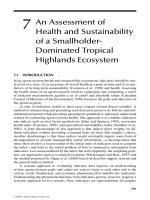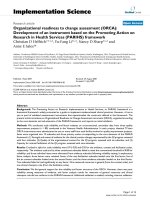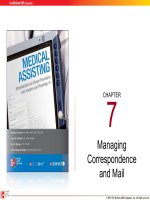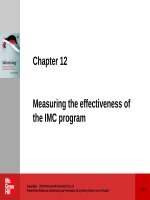Lecture Conducting and reading research in health and human performance (4/e): Chapter 7 - Ted A. Baumgartner, Larry D. Hensley
Bạn đang xem bản rút gọn của tài liệu. Xem và tải ngay bản đầy đủ của tài liệu tại đây (686.43 KB, 12 trang )
Chapter 7
Reading and Evaluating
Research Reports
Disclosure of Research Findings
Culmination of research process is the public
disclosure of results
–
–
–
–
Article in professional journal
Presentation at a conference
Contractual research report
Thesis or dissertation
Typical Contents of Research Report
Preliminary information
Introduction
Methods
Results
Discussion
References
Appendix (if appropriate)
Preliminary Information
Title
– Length should be 15 words or less
Author information
Acknowledgments
Abstract
– May be as short as 150 to 200 words
– Succinct summary of research study
– Not required by all journals
Introduction Section
Typically contains 2 primary elements
– Background information
Acquaints reader with foundation and rationale for
conducting study
– Statement of problem
May also include the research hypothesis, although
less common today
Helps the reader understand why the study was
conducted
Methods Section
Usually contains information about
– Research participants
– Instrumentation
– Procedures
Data collection procedures
Experimental treatments
Data analysis procedures
Methodology and procedures are usually
described in detail
Results Section
That section of a research report in which the
researcher reports the results of the data
collection efforts as well as the outcomes of the
data analysis
Usually includes consideration information from
the various statistical techniques
– Indicate whether H0 was rejected or not
Normally would not include discussion or
interpretation of results
Discussion Section
That section of a research report that contains
an explanation of the results
Interpretation of the findings, culminating with
the conclusions
– Conclusions should relate back to research problem
Provides implications for professional practice
and recommendations for future research
Functions of Discussion Section*
Summarize the results
Interpret the results
Offer conclusions
Theorize
Provide recommendations
Suggest future research
*Adapted from Tuckman (1999)
References & Appendix
Listing of all books, articles, or other sources
cited by the author
Format varies according to specific journal
Astute readers should carefully peruse the list of
references
Appendices are rare in published articles
– Questionnaires
– Tabular information
– Special materials or illustrations
Critiquing a Research Article
Astute readers should be able to critically read
research reports and make informed judgments
about the quality of the research
Published articles vary considerably in quality
– Referred journals
– Nonreferred journals
Criteria for Critiquing an Article
Because of the wide variety of types of research
projects, there is not a universally accepted list
of criteria
Guidelines are similar to those one would follow
for developing a research article
Consult textbook Examples 7.9 and 7.10 for
checklist for evaluating research article









